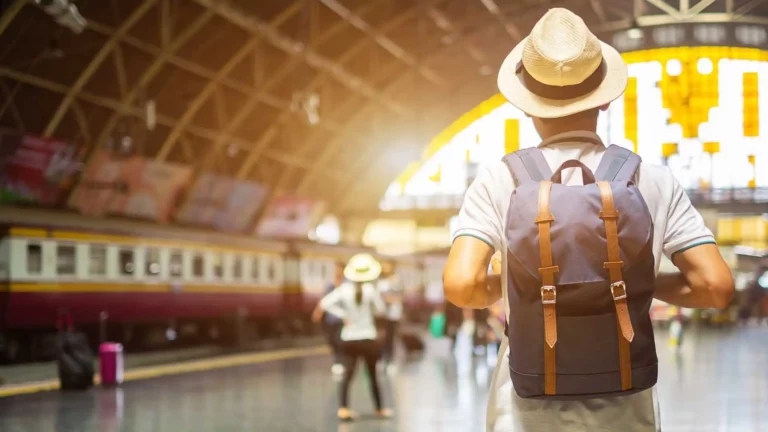Table of Contents
Traveling is one of life’s greatest joys, but it can also be one of the costliest experiences — especially when it comes to the gear you use along the way. Whether you’re planning a backpacking adventure, a weekend getaway, or a luxurious international trip, the gear you choose plays a huge role in shaping your experience. However, good travel gear doesn’t have to break the bank.
In fact, the right durable and versatile gear can actually save you money over time. By investing in high-quality items that stand the test of time, you’ll avoid frequent replacements and costly rentals, plus you’ll enjoy more comfort and convenience during your travels.
In this blog, we’ll explore the best travel gear that not only enhances your experience but also helps you save money in the long run. From durable luggage to multi-purpose gadgets, we’ll show you how the right choices can maximize value without compromising your budget. Plus, we’ll introduce how tools like Beem Everdraft and Beem’s Budget Planner can help keep your travel expenses in check while making smarter decisions.
Understanding the True Cost of Travel Gear
When it comes to buying travel gear, the temptation to go for cheaper options is real — after all, why spend on high-end luggage or expensive gadgets if a cheaper alternative will do? However, while cheap gear might seem cost-effective upfront, it often doesn’t last long enough to justify the savings.
The difference lies in durability. Lower-quality gear might save you money in the short term, but it could end up costing you more when you need to replace it after just one trip or encounter issues like broken zippers, leaky water bottles, or flimsy backpacks. On the other hand, investing in high-quality gear that’s built to last means fewer replacements and more enjoyment during your trips.
By focusing on durability and multi-use functionality, you ensure that your travel gear will not only stand the test of time but also save you money by reducing the need for replacements or last-minute purchases during trips.
Travel Gear That Actually Saves Money

Durable Luggage: Invest Once, Save for Years
The first piece of gear that often needs replacing is luggage. We all know how frustrating it is to deal with broken zippers, worn-out wheels, or cracked suitcase shells during travel. Instead of opting for cheap luggage that may break within a few trips, investing in high-quality, durable luggage pays off in the long run.
- Quality luggage brands: Look for brands like Samsonite, Away, or Osprey that are known for their durability and lifetime warranties. These brands offer luggage with hard-shell construction, smooth-gliding wheels, and sturdy handles, ensuring your bags will withstand rough baggage handling and the wear and tear of constant travel.
- Cost efficiency: Quality luggage may have a higher upfront cost — ranging from $150 to $500 for a carry-on or checked bag. But if your luggage lasts 5 years or more, your cost-per-use becomes incredibly low compared to constantly buying cheap replacements.
Packing Cubes: Maximize Space, Minimize Fees
Packing cubes might seem like a small detail, but they can have a huge impact on your ability to organize your luggage, reduce packing stress, and save money. Packing cubes enable you to fit more items into your luggage and keep everything organized, potentially allowing you to avoid paying for checked luggage or carry-on bags that exceed the weight limit.
- Space efficiency: By using packing cubes, you can fit more items in less space, potentially avoiding the need to pay extra for checked baggage.
- Savings: Packing efficiently also means you’re less likely to need to buy travel accessories or new clothes during your trip because your gear fits comfortably without over-packing.
Reusable Water Bottles: Save on Drinks and Stay Hydrated
Traveling can be dehydrating, especially during long flights or hikes in hot weather. But purchasing bottled water can add up quickly, often costing $5 or more per bottle in airports, tourist spots, or gas stations. The solution? A reusable water bottle that you can refill throughout your journey.
- Eco-friendly: A stainless steel or BPA-free plastic bottle is not only good for your wallet but also better for the environment, as it reduces plastic waste.
- Savings: By refilling your bottle at airport water stations or hotel fountains, you can save hundreds of dollars on bottled water over the course of a year.
E-Reader vs. Paper Books: Save Space, Save Money
For book lovers, the desire to travel with a good collection of novels or guidebooks can add significant weight and space to your luggage. Enter the e-reader — a lightweight device that lets you carry hundreds of books without taking up precious space.
- Cost savings: While an e-reader like a Kindle or Nook may cost around $100 to $200, you can buy digital versions of books for a fraction of the price. Moreover, many classic books are available for free or at discounted prices online.
- Space-saving: An e-reader eliminates the need to pack multiple physical books, saving valuable packing space and weight.
Pro tip: Set up fare alerts for your dream trip months in advance.
Gear That Reduces Hidden Travel Costs
Portable Power Banks: Avoid Costly Charging Fees
One often overlooked cost of travel is charging your devices. At airports or train stations, charging stations can cost anywhere from $5 to $10 per hour. A portable power bank can solve this issue, ensuring that your phone, tablet, or other devices stay charged while you’re on the go without needing to pay for the privilege.
- Multiple charges: A 10,000mAh power bank can charge your smartphone 2-3 times before needing a recharge, and it can fit easily into your bag.
- Savings: By carrying your own power source, you avoid charging fees and ensure that you’re never caught with a dead phone when you need it most.
Travel Insurance: Protect Against Unexpected Expenses
While travel insurance may seem like an additional cost, it can actually save you big bucks if something goes wrong during your trip. Travel insurance covers a range of potential issues, from medical emergencies and trip cancellations to lost luggage and delayed flights.
- Medical expenses: In case of medical emergencies, particularly when traveling abroad, health insurancecoverage might be out of network, leading to high out-of-pocket costs. Travel insurance ensures you’re covered.
- Trip interruptions: Whether your flight is delayed or you need to cancel due to an emergency, having travel insurance can help you avoid significant losses in non-refundable travel costs.
Travel Adapters: Save on International Fees
For international travelers, a universal travel adapter is an essential purchase. Rather than buying multiple adapters for each country you visit, a universal adapter lets you plug into any outlet around the world.
- Cost savings: Travel adapters typically range from $10 to $30. This one-time purchase ensures you can travel anywhere without having to buy separate adapters every time you visit a new country.
- Functionality: Many universal adapters come with USB ports, allowing you to charge multiple devices simultaneously, eliminating the need for extra charging cables or adapters.
Read: How to Use Budgeting Apps to Control Your Finances
Budget-Friendly Travel Gear Recommendations
Affordable Travel Backpacks and Luggage
When it comes to luggage, opting for high-quality, budget-friendly options is key. Look for sturdy, lightweight backpacks, carry-ons, and duffels that won’t break the bank but will last for multiple trips.
- Osprey and REI offer durable, well-designed packs that provide great value for the money. A 40L backpackfrom Osprey can be perfect for both weekend getaways and longer trips, costing around $100-$150.
- Samsonite luggage also offers durable, affordable options, with hard-shell carry-ons starting at $100.
Practical Travel Gadgets That Won’t Break the Bank
Some gadgets are worth investing in when traveling, and they don’t have to be expensive. Consider portable chargers, neck pillows, or noise-cancelling headphones — all of which make your travel experience more comfortable without breaking your budget.
- Anker PowerBanks offer great capacity and charging speed at reasonable prices — typically between $20 and $50.
- Compact, lightweight noise-canceling headphones like those from Sony or Bose can be found at a range of prices starting at around $80-$100, and they can drastically improve long flights or noisy bus rides.
How Beem’s Budget Planner Can Help You Save on Travel Gear?
Set and Track Travel Gear Budgets
Beem’s Budget Planner is a fantastic tool to help you allocate money for your travel gear purchases. Whether you’re saving for luggage, gadgets, or accessories, Beem allows you to create custom categories and track your spending over time.
- Tip: Create a savings goal in Beem for your next travel gear purchase, setting aside a little money each month so you can pay for your next trip’s essentials without stress.
Plan Ahead for Big Purchases
Big-ticket items like luggage or electronics can take a bite out of your budget. Use Beem’s goal-setting feature to plan ahead, spreading out the costs over a period of time and ensuring you don’t overspend.
Read related blog: Who Needs a Financial Advisor When You Have These AI Money Apps?
Common Mistakes to Avoid When Buying Travel Gear
Overspending on Trendy, Low-Quality Items
Opt for durable, versatile gear that will serve you across multiple trips. Avoid the temptation of trendy items that may look great but won’t last or provide long-term value.
Overpacking and Buying Unnecessary Gear
Don’t buy items you won’t use. Focus on multi-purpose gear that offers versatility and can be used in various scenarios, minimizing the need for extra purchases.
Ignoring the Importance of Comfort and Durability
Don’t sacrifice comfort and durability for the lowest price. Investing in comfortable, high-quality gear, like backpacks or travel pillows, can significantly enhance your travel experience and avoid discomfort during your trip.
FAQs on Travel Gear That Actually Saves Money
1. What is the best luggage for budget travelers?
Look for durable, lightweight luggage that fits standard airline size limits. Brands like Samsonite or Osprey offer good options at affordable prices, designed to last longer and avoid baggage fees.
2. How can I save on travel food expenses?
Packing snacks and meals is the best way to save on food expenses during your trip. Avoid buying overpriced snacks at airports by bringing along trail mix, sandwiches, or easy-to-prepare meals.
3. How does a travel water bottle save me money?
A reusable water bottle prevents the need to buy bottled water at airports or tourist destinations, saving you $3-$5 per bottle. Many parks and airports offer free refill stations.
4. Should I buy all my travel gear at once or spread it out?
It’s wise to plan ahead and buy essential items gradually, focusing on durability over time. Be sure to budget using tools like Beem’s Budget Planner to avoid overspending at once.
5. Can Beem’s Budget Planner help me stay within my travel gear budget?
Yes! Beem’s Budget Planner allows you to set savings goals for specific items, track spending, and ensure you don’t go over your budget while shopping for quality travel gear.
Conclusion
Investing in quality travel gear might seem like a big upfront expense, but over time, it saves you money, reduces stress, and makes every trip smoother. Durable luggage, versatile clothing, and reliable accessories like power banks or reusable bottles all pay for themselves through longevity and convenience.
With Beem’s Budget Planner, you can set spending goals for essential travel gear, track your purchases in real time, and stay within budget — ensuring that every item you buy adds real value. And if an urgent travel expense comes up, Beem Everdraft™ offers instant cash access (up to $1,000) with no credit checks or interest, so you’re never caught unprepared.
Together with tools like Cashflow AI for smarter financial insights and Job Loss Protect™ for added peace of mind, Beem helps you travel confidently and plan sustainably.
Download the Beem app today to budget better, spend smarter, and make every journey a financially stress-free adventure.















































